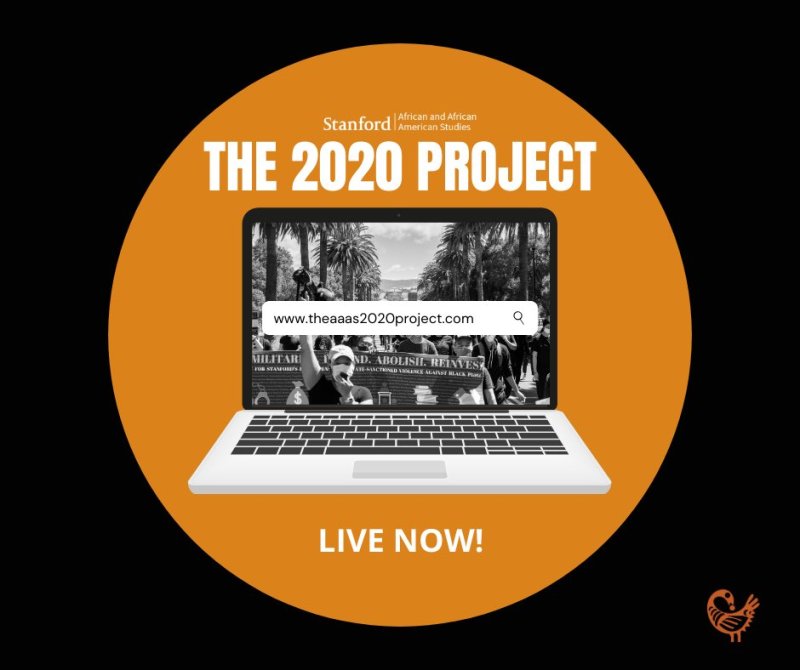“It is our duty to fight for our freedom.
It is our duty to win.
We must love each other and support each other.
We have nothing to lose but our chains.”
-Assata Shakur, “Letter to My People” (1973) (quoted on page 85 of “The 2020 Project”)
“The 2020 Project” is a collection of art, prose, photography, music, etc. regarding the Black experience. The nod to The New York Times’ “1619 Project” aims to bring conversations back to the rampant and perpetual inequalities the Black community faces, recounting the experiences of Black Stanford affiliates.
The publication was synthesized by the African & African American Studies Program at Stanford University (AAAS) with co-editors Kimberly McNair, Hadiya Sewer and Interim Faculty Director Arnetha F. Ball taking the project head on during this critical time. It aims to call for justice for the Black community in this turbulent global political climate.
“As a co-editor alongside Drs Arnetha Ball and Kimberly Thomas McNair, it was a pleasure to have the opportunity to work with the AAAS Team to create the 2020 Project. This special issue publication traces the Black community at Stanford’s experiences, thoughts, and desires during this conjuncture. The wide variety of submissions that we received from Stanford’s alumni, faculty, staff, and students document and reflect on the Covid-19 pandemic, the pervasiveness of anti-blackness, and our visions for justice at Stanford, as well as across the nation and world,” Sewer said in an interview with The Daily.
“This is a critical period in our lives and history. The 2020 Project hopes to contribute to future archives on this moment while providing space for mourning, contemplation, advocacy, and being in our communities, if even virtually. If we listen carefully to the voices of the 2020 Project’s contributors, we can learn a great deal about the critical importance of Black Studies as a vehicle for healing and social transformation.”
“The 2020 Project” starts strong with the painting “Intersectionality” by African & African American Studies Associate Director Katie Dieter. The piece is beautifully infused with vibrant color with people standing on islands in the sky. I see the different islands as representing stratification even within marginalized groups.
In an interview with The Daily, Dieter commented on her art, “This piece explores the concept of intersectionality, which was coined by Professor Kimberlé Crenshaw and examines the ways that our identities overlap or intersect, impacting our engagement with oppression, domination, and discrimination. The painting points to the violence, terror, and marginalization that Black women face due to their intersectional identities, but also to the resiliency and resistance that arises, in spite of these struggles.”
Pages later, in an essay titled “It’s About the Land,” Ayoade Balogun ’21 poignantly describes that the Black community is treated as “Disposable . . . tossed aside like plastic packaging.” While “pay gaps continue, [and] bodies are brutalized,” Black culture is essentially treated as cheap. It is unsettling to read of how expendable an entire population feels for merely the color of their skin and the beautiful culture that surrounds them.
Advancing through the project, “I Can’t Anymore Stanford,” a poem by Ariel Calderon, a Ph.D. student in the immunology program at the School of Medicine, provides a striking account of the daily discriminations that people attune their eyes and minds to. Calderon describes his frustration with “being confused for another black student with long hair on a regular basis.” He also describes the upsetting situations of white people crossing the street just to avoid passing him on the sidewalk, being seen as a threat for merely wearing a hoodie. He cannot even walk around campus at night without fearing that the police might be called.
Discourse is the first step in creating change, promoting awareness. “The 2020 Project” is the epitome of a conversation starter, the best way to work toward a better tomorrow. The magazine is an excellent amalgamation of many opinions on the Black experience.
“The project was envisioned as a way for the broader Black community at Stanford to emotionally process and address the critical issues of our times. We wanted to chronicle the ways Black people were documenting and understood their experiences during the COVID-19 pandemic and uprisings inspired by the deaths of Black people by law enforcement or vigilantes,” McNair said in an interview with The Daily.
“These human rights issues and violations of community trust have not only breathed new life into ‘Black Lives Matter’ as a rallying cry, global movement, and organization but also illustrates the need for Black Studies as a field of inquiry and analytical lens. We hoped to capture the ways members of the Black community at Stanford not only critique the anti-Blackness faced on campus and in broader society but also the spaces in which they find community, express desires, take pride and have joy.”
Contact Matthew Ayoob at mayoob ‘at’ stanford.edu.
